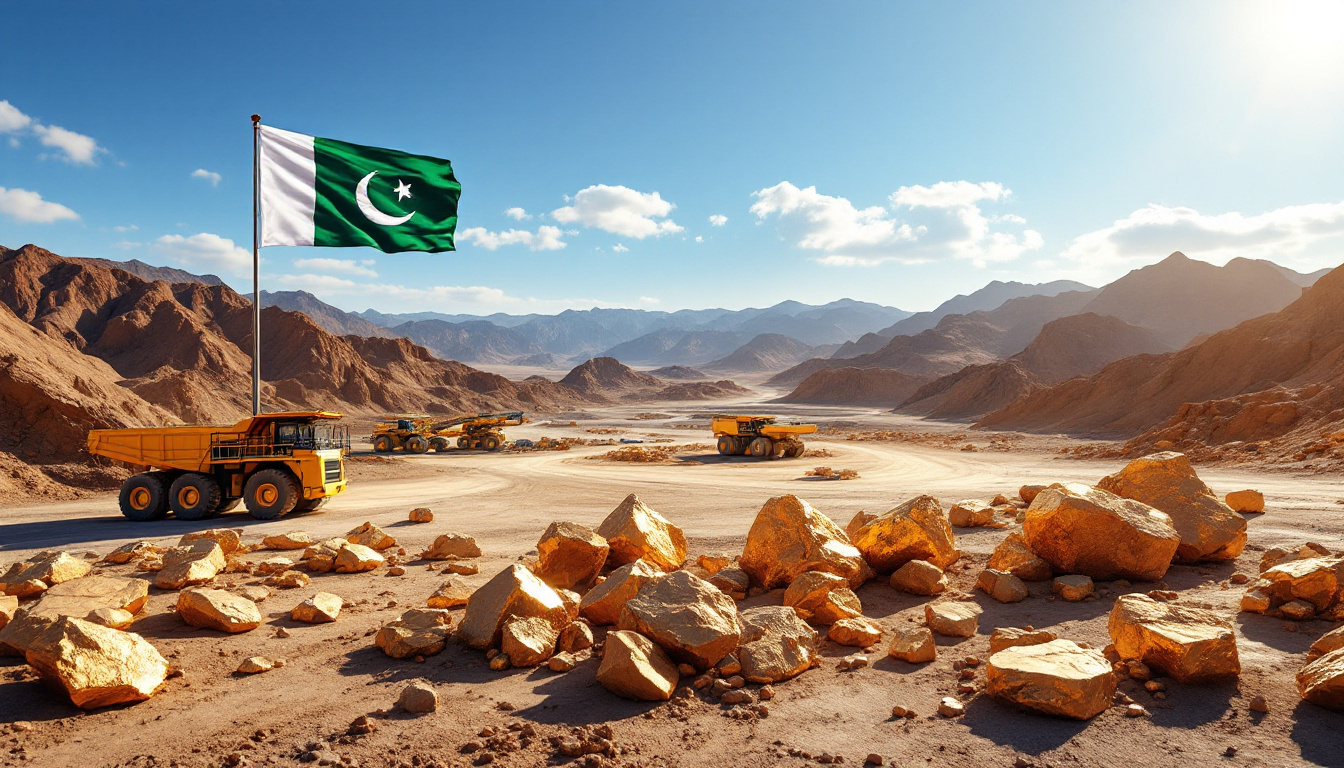The Growing Concentration Problem in Critical Minerals
The global landscape of critical minerals is experiencing unprecedented concentration, creating significant vulnerabilities for industries dependent on these resources. Recent data from the International Energy Agency (IEA) reveals alarming trends that undermine Western efforts to diversify critical minerals and supply chain away from dominant producers.
Current Market Concentration Statistics
The average market share controlled by the top three refining nations for key critical minerals has increased from 82% in 2020 to 86% in 2024, according to the IEA's Critical Minerals Market Review. This concentration has occurred despite numerous initiatives aimed at diversification.
China maintains a commanding position, dominating refining operations for 19 of 20 strategic minerals analyzed, with an average market share of approximately 70%. This dominance extends across the entire value chain for many minerals, from mining to processing and manufacturing.
Perhaps most concerning is that 55% of strategic minerals tracked by the IEA are currently subject to some form of export controls, limiting global access to these crucial resources.
The trend toward greater concentration is accelerating, with China and Indonesia collectively contributing 90% of the supply growth in cobalt, graphite, rare earths, and nickel over the past four years.
Supply Chain Vulnerabilities
Critical mineral supply chains exhibit extreme fragility compared to conventional commodities. Three-quarters of strategic minerals show greater price volatility than oil, while half display more volatility than natural gas—traditionally one of the most price-unstable energy commodities.
This volatility creates significant downstream impacts. According to IEA modeling, a sustained supply shock could increase global battery pack prices by 40-50%, potentially derailing electric vehicle adoption targets and renewable energy deployment schedules.
"The increasing concentration of critical mineral supply chains represents one of the most significant challenges to the energy transition. Countries and companies that fail to secure reliable access may find themselves at a permanent competitive disadvantage," warns Fatih Birol, Executive Director of the International Energy Agency.
The vulnerability extends beyond clean technology. Defense systems, semiconductors, and other advanced manufacturing sectors face similar exposure to supply disruptions, creating national security concerns for Western nations.
What's Driving the Increasing Concentration?
Market Forces and Economic Factors
Several economic factors are accelerating the concentration of critical mineral supply chains rather than alleviating it.
Incumbent producers, particularly China and Indonesia, have strategically flooded markets with supply, keeping prices artificially low and deterring investment in alternative production sources. This approach leverages existing economies of scale and technological advantages that new market entrants struggle to match.
Western nations face significant economic hurdles when attempting to establish competing supply chains. These include:
- Higher labor and compliance costs
- More stringent environmental regulations
- Less access to subsidized financing
- Limited technical expertise in specialized refining processes
- Longer permitting timelines (averaging 16 years for new mines in the United States)
By-product dependency creates additional vulnerability for many critical minerals. Elements like gallium, germanium, and tellurium are typically produced as by-products of other mining operations, meaning their supply is tied to the economics of primary metals rather than their own market demand.
Price volatility further complicates diversification efforts. The boom-and-bust cycles common in critical minerals markets deter long-term investment, as demonstrated by lithium's price collapse from $80,000/t in late 2022 to around $8,350/t today.
Geopolitical Weaponization of Resources
Critical minerals have increasingly become tools of geopolitical leverage. China has implemented strategic critical minerals order on multiple resources, including:
- Heavy rare earths (2010, 2022)
- Gallium and germanium (July 2023)
- Graphite (December 2023)
These actions reflect a deliberate strategy to maintain dominance in clean energy supply chains while creating leverage over Western manufacturers who depend on these resources.
Trade disruptions have become increasingly common as nations leverage resource control. Indonesia's ban on nickel ore exports in 2020 forced Chinese and international companies to establish processing facilities within Indonesia, effectively capturing more of the value chain domestically.
Western nations have announced ambitious initiatives to counter these trends, including the U.S. Inflation Reduction Act and the EU Critical Raw Materials Act. However, implementation has lagged behind rhetoric, with few concrete projects reaching production stage.
"The gap between Western policy announcements and actual operational capacity continues to widen," notes Vivek Dhar, analyst at Commonwealth Bank. "Without urgent policy intervention, the concentration of critical mineral supply chains will continue to grow."
Industry analysis suggests prolonged supply disruptions could widen manufacturing cost disadvantages for non-Chinese producers by 15-25% for technologies like batteries, permanent magnets, and semiconductor components.
What Does the Future Hold for Critical Minerals Supply?
IEA Projections Through 2040
Despite growing awareness of supply chain vulnerabilities, IEA modeling indicates concentration will remain a persistent challenge.
Rare earths mining concentration is projected to remain stable at 86% controlled by the top three countries (China, Australia, and Myanmar) through 2040. Even more concerning, rare earths refining concentration will decrease only marginally from 92% to 82% by 2040—maintaining China's effective monopoly on these crucial elements.
Across all critical minerals, the average market share of the top three refiners is expected to decline to 82% by 2035. However, this modest improvement merely returns concentration levels to where they were in 2020, highlighting the limited progress despite significant policy attention.
The forecast for specific minerals remains concerning:
| Mineral | Top 3 Refiners' Market Share (2035) |
|---|---|
| Rare Earths | 92% |
| Graphite | 90% |
| Lithium | 85% |
| Cobalt | 80% |
| Nickel | 72% |
These projections assume successful implementation of all currently announced projects—an optimistic scenario given the high failure rate of mining developments globally.
Expert Analysis on Market Trajectories
Industry experts emphasize that market forces alone are insufficient to address the imbalance.
"The economics of critical mineral processing heavily favor incumbents, especially China," explains Dr. Jane Morgan, resource security specialist at the Center for Strategic and International Studies. "Without coordinated policy intervention that spans the entire value chain, from mining to refining to manufacturing, Western nations will continue to lose ground."
Particular concern surrounds permanent magnets, essential components for electric vehicles and wind turbines. China currently controls over 90% of global production capacity, with minimal alternative supply expected to materialize before 2030.
The IEA assessment concludes that Western manufacturers face significant disadvantages without more aggressive policy action, potentially locking in technological and manufacturing dependencies for decades to come.
How Are Major Mining Companies Responding?
Rio Tinto's Strategic Pivot
While government responses have been inconsistent, some major mining companies are taking proactive approaches to critical mineral supply chains. Rio Tinto has demonstrated greater willingness than competitors to diversify into energy transition minerals.
The company is positioned to become the world's second-largest lithium producer by 2035, following a series of strategic investments:
- $10 billion acquisition of Argentina producer Allkem
- $2.5 billion commitment to build the 60,000tpa Rincon project in Argentina
- $880 million contribution to develop the Maricunga Salar with Chilean state copper company Codelco
- 51% partnership with Chilean state company ENAMI to develop the Altoandinos project
Rio Tinto CEO Jakob Stausholm explains the company's counter-cyclical approach: "We're investing through the cycle because we believe fundamentally in the long-term demand growth for these critical minerals. The current price environment creates acquisition opportunities that align with our long-term strategy."
Beyond lithium, Rio is exploring opportunities in other critical minerals including scandium, gallium, and graphite. The company recently acquired a 20% stake in Sovereign Metals, which is developing the Kasiya rutile and graphite project in Malawi—potentially one of the world's largest sources of natural graphite.
Contrasting Approaches Among Major Miners
Rio Tinto's aggressive move into battery metals contrasts sharply with more conservative approaches from competitors like BHP and Glencore, which have focused primarily on copper rather than diversifying across the full spectrum of energy transition minerals.
This divergence reflects different assessments of future market dynamics. Rio is playing a long-term strategy, anticipating lithium deficits emerging by the end of the decade despite current oversupply. The company's analysis suggests that even with today's lithium carbonate prices at $8,350/t (down from $80,000/t in late 2022), new production will be needed to meet 2030 demand projections.
"Rio Tinto is making a calculated bet that current price weakness is temporary," says Tim Richards, mining analyst at Global Resource Insights. "Their counter-cyclical investments could position them advantageously if and when supply constraints reemerge."
The contrast in strategies also reflects differing capabilities and assets. Rio's existing operational footprint in areas with lithium potential, particularly in the Americas, provides a natural pathway to diversification that other majors may lack.
What Policy Interventions Could Address Supply Chain Concentration?
Potential Government Actions
Addressing critical mineral supply chain concentration requires coordinated policy interventions across multiple dimensions:
-
Direct investment in domestic processing and refining capabilities
- Public-private partnerships for demonstration facilities
- Strategic infrastructure development in energy, water, and transportation
- Workforce development programs for specialized technical skills
-
Strategic mineral stockpiling programs
- Establishment of national critical minerals reserve for high-risk materials
- Coordination of private sector inventory management
- International agreements for shared access during emergencies
-
Trade agreements focused on critical mineral supply security
- Friend-shoring arrangements with allied nations
- Standardized environmental and labor requirements
- Coordinated response mechanisms for supply disruptions
-
Research and development funding
- Alternative materials development
- Advanced recycling technologies
- Process improvements to reduce material intensity
- Substitution strategies for highest-risk minerals
-
Incentives for private sector investment
- Tax benefits for domestic processing facilities
- Loan guarantees for qualifying projects
- Streamlined permitting processes while maintaining environmental standards
- Long-term offtake agreements from government entities
These policy approaches must be tailored to specific mineral supply chains, as each faces unique challenges and opportunities for diversification.
The Cost of Inaction
The consequences of failing to address critical mineral supply chain concentration extend far beyond economic considerations.
Continued vulnerability to supply disruptions and price volatility threatens to undermine climate goals, as clean energy technologies depend heavily on secure access to these materials. The IEA estimates that a major supply disruption could delay clean energy deployment targets by 3-5 years in affected regions.
Reduced industrial competitiveness for Western manufacturers would have cascading effects through economies, potentially eliminating millions of high-skilled manufacturing jobs and associated economic activity.
Perhaps most concerning is the dependency on potentially hostile nations for strategic resources essential to both civilian infrastructure and defense capabilities. This dependency creates significant geopolitical leverage that could be exploited during periods of international tension.
The ability to respond to future supply shocks would be severely limited without diversified supply chains, potentially leaving Western economies vulnerable to coordinated market manipulation or export restrictions.
How Are Critical Mineral Prices Responding to Market Conditions?
Current Price Trends
The critical minerals market has experienced extreme volatility over the past 24 months, with several key minerals seeing dramatic price corrections:
- Lithium carbonate prices have collapsed to $8,350/t from peaks of over $80,000/t in late 2022
- Spodumene concentrate (lithium ore) is trading at approximately $645/t, a four-year low
- Lithium mining stocks have seen significant declines (Liontown Resources -16.5%, Pilbara Minerals -13.4% in recent trading)
- Cobalt prices have fallen 75% from 2022 peaks
- Rare earth prices have declined 60-70% for most elements
These price corrections reflect a combination of factors:
- Rapid supply growth, particularly from Chinese and Indonesian sources
- Slower-than-expected electric vehicle adoption in Western markets
- Continued oversupply in lithium due to new projects coming online
- Economic uncertainty affecting demand projections
In contrast, gold prices have broken above $3,300/oz, benefiting gold-focused miners as investors seek safe-haven assets amid global uncertainty.
Market Performance Indicators
The broader mining sector shows divergent performance based on commodity focus:
- The ASX 300 Metals and Mining Index rose 1.17% over the past week
- Silver-focused Adriatic Metals gained 32.9% following takeover interest
- Gold miners showed strong performance (West African Resources +19.8%, Predictive Discovery +19.7%)
- Coal producer Coronado Global Resources fell 32.9% amid reports of potential debt acquisition
This divergence highlights the growing separation between traditional energy minerals and critical minerals energy markets, with the latter experiencing more volatility and uncertainty.
Analysts note that current price levels for many critical minerals have fallen below the marginal cost of production for Western producers, creating unsustainable market conditions that will eventually trigger supply rationalization.
"The current pricing environment is separating low-cost producers from marginal operations," explains mining economist Dr. Sarah Chen. "We expect to see project delays, capacity reductions, and corporate restructuring in the coming quarters as the industry adjusts to economic realities."
How Can Supply Chain Resilience Be Improved?
Building Diversified Supply Networks
Creating resilient critical mineral supply chains requires a comprehensive approach that addresses vulnerabilities at each stage of the value chain.
Critical Infrastructure Development
Investment in processing facilities outside of China represents the most urgent priority. While mining operations are relatively dispersed globally, refining and processing remain highly concentrated. Specific opportunities include:
- Rare earth separation facilities in the United States, Europe, and Australia
- Battery-grade lithium hydroxide and carbonate production in North America
- Graphite anode material processing outside of China
- Nickel sulfate and cobalt sulfate refining capacity expansion
Development of alternative extraction technologies could unlock new resource potential. Promising approaches include:
- Direct lithium extraction from brines and geothermal waters
- Advanced leaching techniques for low-grade rare earth deposits
- Hydrogen-based reduction processes for nickel laterites
- Bioprocessing technologies for complex polymetallic ores
The creation of circular economy systems for critical minerals would reduce dependency on primary production:
- Battery recycling infrastructure with standardized collection systems
- Urban mining from electronic waste
- Reprocessing of mining wastes and tailings
- Design standards that facilitate material recovery
Establishment of strategic mineral reserves, similar to petroleum reserves maintained by many countries, could provide buffer against short-term supply disruptions:
| Mineral | Recommended Reserve (months of consumption) | Estimated Cost ($B) |
|---|---|---|
| Rare Earths | 6-12 | 0.8-1.5 |
| Lithium | 3-6 | 2.0-4.0 |
| Cobalt | 4-8 | 1.2-2.4 |
| Graphite | 3-6 | 0.5-1.0 |
| Nickel | 2-4 | 3.0-6.0 |
International Cooperation Frameworks
Formation of mineral security alliances among like-minded nations could create scale and leverage that individual countries lack. The Minerals Security Partnership launched in 2022 represents an early attempt at such cooperation, bringing together 14 countries including the United States, Japan, and European Union members.
Standardization of environmental and social governance requirements would level the playing field for producers while ensuring responsible production practices:
- Common standards for carbon emissions reporting
- Water usage and management protocols
- Community engagement requirements
- Mine closure and reclamation planning
Coordinated research and development initiatives would maximize impact and prevent duplication of efforts:
- Shared access to pilot facilities and testing capabilities
- Open-source approaches to certain pre-competitive technologies
- International exchange programs for technical specialists
- Harmonized technical standards for critical mineral products
Joint financing mechanisms for new production capacity could overcome the capital constraints facing many projects:
- Multilateral development bank involvement
- Sovereign wealth fund participation
- Public-private partnerships for shared infrastructure
- Blended finance approaches combining public and private capital
FAQ: Critical Minerals Supply Chain Challenges
What are the most concentrated critical mineral supply chains?
Rare earths, graphite, and lithium have the highest concentration levels, with the top three producers controlling 92%, 90%, and 85% of refined supply respectively, according to IEA projections for 2035. This concentration is particularly concerning for heavy rare earths like dysprosium and terbium, where China controls over 95% of separation capacity.
Why hasn't the market naturally diversified critical mineral supply?
Incumbent producers have maintained artificially low prices through supply flooding, while high capital costs, technical expertise requirements, and regulatory hurdles create significant barriers to
Ready to Stay Ahead of the Next Major Mineral Discovery?
Discover real-time alerts on significant ASX mineral discoveries with Discovery Alert's proprietary Discovery IQ model, giving you immediate insights into actionable opportunities across all commodities. Explore how historic discoveries have generated substantial returns by visiting our dedicated discoveries page and position yourself ahead of the market.




